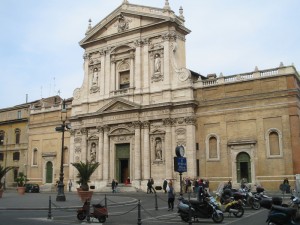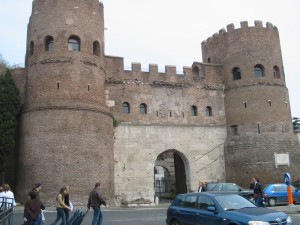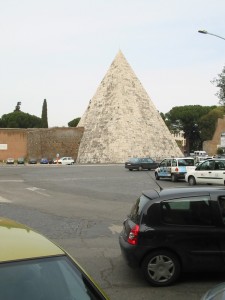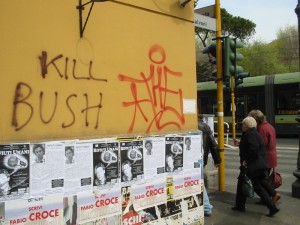Rome was a poem pressed into service as a city.
(Anatole Broyard 1920 – 1990)
Before we continue where we left off, let me be perfectly clear on one point.
The fact that the Pope died the day after we arrived in Italy is just a coincidence. I’m not sure I can stress this enough. A coincidence. He was already quite ill. Look it up.
Sunday: a Day of Rest?
We let Cara sleep in while we once again braved the Metro in search of a Mass in English. Later, we would discover that this was not as difficult as it first appears. For today, however, we headed for the only English-language church we knew about: Santa Susanna.

We swung by the flat to pick up Cara and then headed for the wrong side of the river: Trastevere. Specifically, we went to its infamous Porta Portese market. Billed as the largest flea market in Rome, Porta Portese begins near the only pyramid in the city and goes on for kilometers through a fairly rough neighbourhood.
Key requirements here are good humour, a moneybelt, and a deep aversion to shell games and Gypsies. It reminded me very much of parts of Chicago.

I brought 45 Euro to spend, and I’d already spent five on a shirt.
After trying on the coat, the fellow offered to let it go for 100. Francine played the part of the enthusiastic translator, and I acted the part of the indifferent customer. I kept saying “no”, and she kept spinning tales.
Several times, I just walked away. Francine and I mock-argued; she apologetically told him “no” again.
As I said before, I had 40 Euro on my person. And in the end, that’s exactly what I spent.

Note the cars for scale.
To Manziana and Beyond!
Along the hazy shores of the Lake of Hali Lago de Bracchiano sits the ancient city of Carcosa hill-town of Manziana. Being in Europe (where history comes from), it has a castle properly looming on the hillside above. It also contains Uncle Settimio’s pensione – his smaller, second condo.
Having lost Leone somewhere along the way, Francine, Cara, and I had tea with Settimio and his wife Rosetta (no relation to the stone, thank you). We tooled around Manziana’s local market (originally set up by Pope Clement XII according to a nearby sign of dubious authenticity) and met even more relatives.
This market was far more interesting to me than the “buy it wholesale” shysterama of Porta Portese. There was actually some cool junk for sale here: rusted machines of forgotten purpose, crumbling Latin breviaries, antique furniture stored for generations in a barn with the pigs – that sort of thing.
If I could have figured out how to fit it in my luggage, I’d have bought the slightly rusty iron mould and press for making hosts (or “Jesus bread” according to Francine in a moment of ditz). I have no idea what I would do with it, but man was it neat.

Another night of eating, laughing, and drinking. Settimio kept pouring Sambuca in my glass, and he was matching me swallow for swallow. I had eerie flashbacks to my Onkel Otto.
We heard that the Pope would be lying in state beginning the next day, so I was resolved to go to the Vatican in the morning. I think both Francine and Cara thought I was slightly insane (or perhaps was just too deep into my Sambuca), but I was determined.
Had I known anything about what the Vatican’s plans actually were, I might have hesitated. Ignorance, as they say, bliss. This is one occasion where I now take comfort in my cluelessness.
On to Day Four!